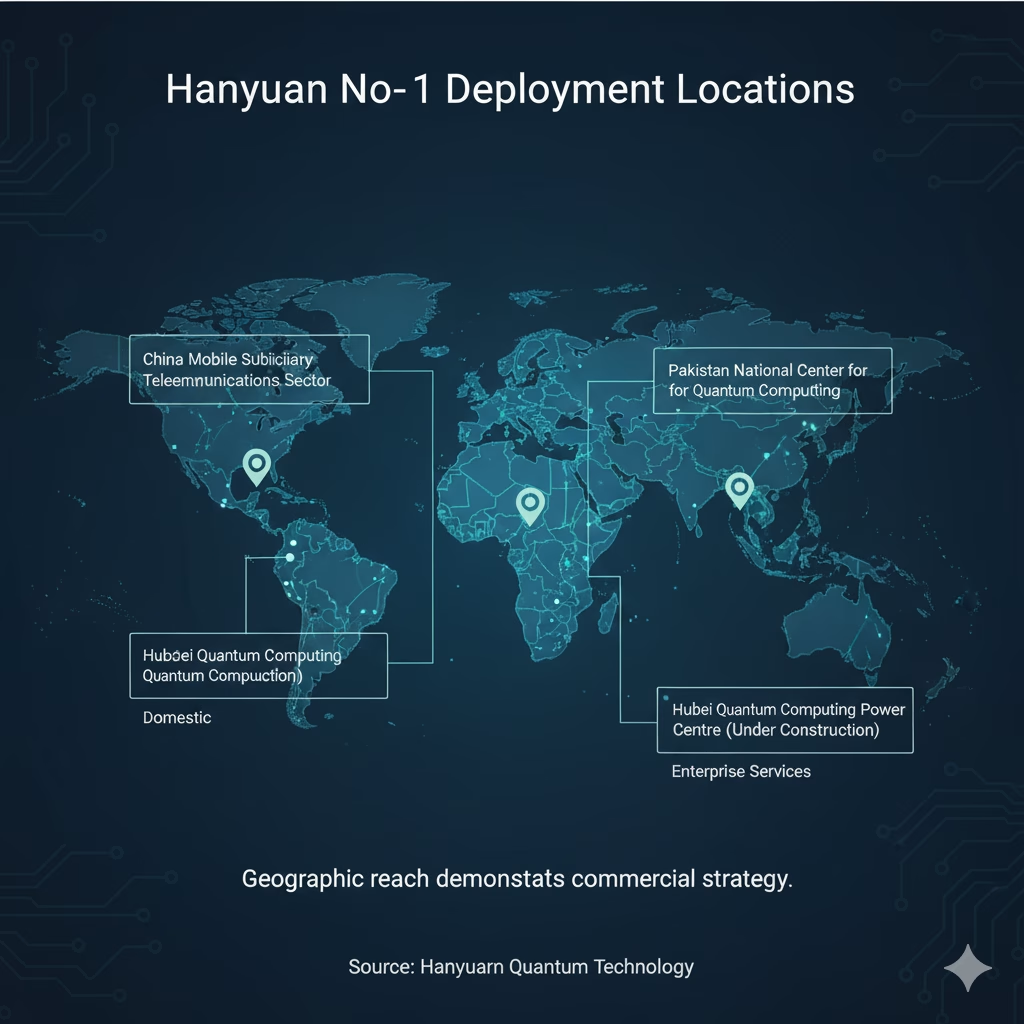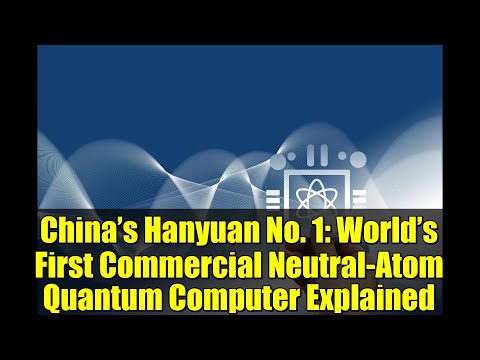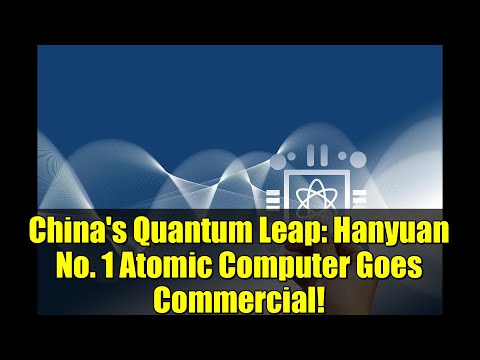China’s Hanyuan No. 1: The Room-Temperature Quantum Computer That Just Went Commercial
How China’s first neutral-atom quantum computer secured $5.6 million in orders and reshaped the global quantum computing race with technology that operates without extreme cooling
⚡ Quick Verdict: China’s Commercial Quantum Breakthrough
In a watershed moment for quantum computing commercialisation, China’s first atomic quantum computer, “Hanyuan No. 1,” has entered commercial use with more than 40 million yuan ($5.6 million USD) in orders. Developed by the Chinese Academy of Sciences’ Innovation Academy for Precision Measurement Science and Technology, this 100-qubit system represents a fundamentally different approach to quantum computing that could reshape the industry.
Commercial traction is real: The system has been delivered to a China Mobile subsidiary for telecommunications applications and internationally to Pakistan, which recently signed an MoU with China to establish its National Center for Quantum Computing. With over 50 universities and companies exploring quantum applications through the platform, and a dedicated quantum computing power centre under construction, Hanyuan No. 1 marks China’s aggressive move toward quantum commercialisation.
The reality check: Whilst 100 qubits is smaller than cutting-edge systems from Google (105) or IBM (1000+ roadmap), the room-temperature operation, compact form factor, and proven commercial deployments signal that neutral-atom quantum computing is transitioning from research to reality faster than many predicted.
🚀 What Makes Hanyuan No. 1 Different: The Technology Explained
To understand why Hanyuan No. 1 matters, we must first grasp why most quantum computers are extraordinarily difficult and expensive to operate — and how neutral-atom technology offers a fundamentally different path.
The Superconducting Quantum Computer Challenge
Google’s Willow chip, IBM’s quantum processors, and most leading quantum computers use superconducting qubits — tiny electrical circuits that only exhibit quantum behaviour at temperatures approaching absolute zero:
- Operating temperature: 15 millikelvin (-273.135°C)
- Cooling requirement: Dilution refrigerators costing millions of dollars
- Energy consumption: Massive power draw for cryogenic systems
- Physical footprint: Entire rooms dedicated to cooling infrastructure
- Maintenance: Constant monitoring and expensive helium-3 refrigerants
Neutral-Atom Quantum Computing: A Different Paradigm
Hanyuan No. 1 employs a radically different approach called neutral-atom quantum computing (internationally) or atomic quantum computing (Chinese terminology). Here’s how it works:

Visual comparison showing superconducting qubits vs neutral atom qubits. Neutral atoms are trapped and manipulated using optical tweezers (focused laser beams) at room temperature, whilst superconducting circuits require extreme cryogenic cooling. Source: Quantum computing architecture comparison
The neutral-atom advantage:
- Room temperature operation: Atoms are cooled to ultracold temperatures (near absolute zero) but the quantum computer’s environment operates at room temperature — no cryogenic infrastructure required
- Optical tweezer control: Individual atoms (typically rubidium or caesium) are trapped using focused laser beams called “optical tweezers”
- High-fidelity operations: Atoms are identical by nature, providing inherently consistent qubits
- Scalability: Adding more qubits is theoretically simpler — just trap more atoms in your optical lattice
- Compact footprint: Hanyuan No. 1 fits in three standard equipment racks vs entire rooms for superconducting systems
| Technology Aspect | Superconducting (Google/IBM) | Neutral Atom (Hanyuan No. 1) | Advantage |
|---|---|---|---|
| Operating Environment | 15 millikelvin cryogenic | Room temperature | Neutral Atom |
| Energy Consumption | Very high (cryogenic cooling) | 1/10th of foreign systems (per Chinese sources) | Neutral Atom |
| Physical Footprint | Entire dedicated facility | 3 standard equipment racks | Neutral Atom |
| Qubit Count (Current) | 105 qubits (Google Willow) | 100 qubits (Hanyuan No. 1) | Comparable |
| Error Correction | Below-threshold achieved (Google) | Not yet publicly demonstrated | Superconducting |
| Commercial Deployment | Research/enterprise partnerships | $5.6M in confirmed orders | Both progressing |
🏭 The Hubei Advantage: Building a Domestic Quantum Supply Chain
One of the most strategically significant aspects of Hanyuan No. 1 isn’t just the technology — it’s how and where it was built. The project exemplifies China’s broader strategy of achieving technological self-sufficiency whilst leveraging regional industrial strengths.
Optics Valley: China’s Photonics Manufacturing Hub
Hanyuan No. 1 was developed in Wuhan, Hubei Province, home to “Optics Valley” (光谷) — China’s premier optoelectronics and photonics manufacturing cluster. This wasn’t coincidental; neutral-atom quantum computing relies heavily on laser technology and optical components.
“The project leveraged Hubei’s strong optoelectronics manufacturing base to build a domestic supply chain for quantum computing components. Engineers succeeded in producing high-performance lasers that meet the precision control requirements for atomic qubits whilst consuming only one-tenth the energy of comparable foreign systems.”— Hubei Daily, November 2025
The domestic supply chain strategy includes:
- Laser manufacturing: High-precision lasers for optical tweezer qubit control
- Optical components: Mirrors, beam splitters, optical isolators, and waveguides
- Chip growth and packaging: Complete R&D pipeline from design to system testing
- System integration: Testing facilities and quality control infrastructure
- Cloud platform development: User-friendly quantum computing interfaces
Multi-Institution Collaboration
According to reports, the Hanyuan project involved extensive collaboration across China’s quantum research ecosystem:
- Chinese Academy of Sciences: Innovation Academy for Precision Measurement Science and Technology (lead developer)
- Wuhan University: Quantum algorithm and cloud platform development
- Huazhong University of Science and Technology: Hardware engineering
- Zhongke Kuyuan Technology: Commercial system integration
- Optics Valley Information Optoelectronics Innovation Centre: Component manufacturing
- Wuhan Institute of Quantum Technology: Application development
This model — combining academic research, regional manufacturing strengths, and commercial partners — mirrors successful technology cluster strategies globally (Silicon Valley, Route 128, Shenzhen) but with heavy state coordination.
💼 Commercial Traction: From Lab to Market
The $5.6 million in confirmed orders represents more than revenue — it validates that neutral-atom quantum computing can transition from research to commercial deployment. Here’s what we know about the early adopters:
China Mobile Subsidiary: Telecommunications Applications
The first commercial Hanyuan-1 unit was delivered to a subsidiary of China Mobile, one of the world’s largest telecommunications operators. Whilst specific use cases weren’t disclosed, potential applications include:
- Network optimisation: Routing and traffic management across massive telecommunications infrastructure
- Quantum cryptography: Integration with China Mobile’s quantum communication initiatives
- Resource allocation: Optimising base station placement and spectrum utilisation
- Financial modeling: China Mobile has extensive fintech operations requiring complex calculations
China Mobile announced in October 2025 a major quantum technology initiative, making the Hanyuan No. 1 purchase part of a broader quantum computing and communication strategy.
Pakistan: International Expansion
Pakistan placed an order for Hanyuan No. 1 as part of a broader Memorandum of Understanding (MoU) signed in October 2025 to collaborate on quantum technologies under the China-Pakistan Economic Corridor’s second phase.
The Pakistan quantum partnership includes:
- National Center for Quantum Computing: China will assist Pakistan in establishing its first quantum computing facility
- Technology transfer: Knowledge sharing in quantum computing and quantum communication
- Research collaboration: Joint quantum technology development projects
- Training programmes: Developing Pakistan’s quantum workforce

Visual map showing confirmed deployments: China Mobile subsidiary (telecommunications sector, domestic), Pakistan National Center for Quantum Computing (international collaboration), and the under-construction Hubei quantum computing power centre (enterprise services). Geographic reach demonstrates commercial strategy.
Applications in Development
According to Hubei Daily, the system can handle complex applications in:
- Financial modeling: Risk analysis, portfolio optimisation, derivative pricing
- Logistics optimisation: Supply chain routing, warehouse management, delivery scheduling
- Industrial systems modeling: Manufacturing process optimisation
- Materials research: Future applications in materials design and drug discovery
More than 50 universities and companies have reportedly joined the project to explore quantum applications, suggesting an ecosystem is forming around the technology.
🌐 The Quantum Computing Power Centre: Building Infrastructure
Beyond selling individual systems, the Hanyuan project team is constructing China’s first neutral-atom quantum computing power centre — a facility designed to provide continuous quantum computing services to enterprise clients.
The Quantum-as-a-Service Model
The planned facility represents a shift toward “quantum-as-a-service” (QaaS) — similar to cloud computing models where users access quantum processors remotely rather than purchasing and operating their own systems.
Planned capabilities include:
- 24/7 quantum computing services: Continuous availability for enterprise workloads
- Clustered quantum processors: Multiple Hanyuan systems working in parallel
- Cloud-based interface: Users can design and test quantum algorithms without specialised physics knowledge
- Visual programming tools: Simplified quantum algorithm development
- Hardware optimisation: Automatic tuning for specific problem types
- Large-scale simulation: Hybrid classical-quantum computing approaches
The centre is expected to serve more than 1,000 enterprise clients annually, focusing on computationally demanding problems like financial risk analysis and industrial system modeling.
Competing with IBM and Amazon
This infrastructure strategy positions Hanyuan directly against established quantum cloud services:
- IBM Quantum Network: Cloud access to superconducting quantum processors
- Amazon Braket: Multi-vendor quantum computing service
- Microsoft Azure Quantum: Hybrid quantum-classical cloud platform
- Google Quantum AI: Research partnerships and enterprise access
The room-temperature operation and lower energy costs could give Hanyuan a competitive advantage in operating costs, though technical performance comparisons remain limited.
⚠️ Challenges & Limitations: The Realistic Assessment
Despite the commercial breakthrough, neutral-atom quantum computing and Hanyuan No. 1 specifically face significant challenges:
Technical Challenges
- Error correction: No public demonstration of below-threshold quantum error correction (Google’s Willow achieved this in December 2024)
- Qubit coherence times: Maintaining quantum states long enough for complex calculations
- Scalability uncertainties: Whilst theoretically easier to scale, practical demonstrations of 1000+ qubit neutral-atom systems are limited
- Performance benchmarks: Limited public data on actual performance vs classical supercomputers on specific problems
Commercial & Strategic Challenges
- International market access: US export controls and geopolitical tensions may limit global commercialisation
- Technology verification: Independent verification of performance claims by international researchers is limited
- Talent competition: Global race for quantum computing expertise
- Application development: Quantum algorithms for specific industry problems are still maturing
Competitive Landscape
Hanyuan No. 1 operates in an increasingly crowded field:
- QuEra (US): Neutral-atom quantum computers with 256-qubit systems
- Pasqal (France): Neutral-atom approach with European partnerships
- Atom Computing (US): Partnership with Microsoft, 1000+ qubit roadmap
- Caltech researchers: Recently demonstrated 6,100-qubit neutral-atom array
🤖 Interactive Learning: Explore With AI
Deepen your understanding of neutral-atom quantum computing and China’s quantum strategy with these AI prompts:
“Explain how neutral-atom quantum computers work using optical tweezers to trap and manipulate individual atoms. Why does this approach allow room-temperature operation when superconducting qubits require extreme cooling? What are the trade-offs?”
“Create a comparison table of superconducting qubits (Google, IBM), trapped ions (IonQ, Quantinuum), and neutral atoms (Hanyuan No. 1, QuEra, Atom Computing). Include: operating temperature, scalability, error rates, commercial readiness, and typical applications.”
“Analyse China’s quantum computing strategy based on Hanyuan No. 1, the Pakistan partnership, and domestic supply chain development. How does this fit into China’s broader technology self-sufficiency goals? What are the geopolitical implications?”
“I’m considering quantum computing services for financial risk modeling and logistics optimisation. Should I explore China’s Hanyuan neutral-atom systems, IBM’s superconducting quantum network, or wait for more mature technology? What factors should guide my decision?”
“Explain the physics of optical tweezers for quantum computing. How do focused laser beams trap neutral atoms? What determines the fidelity of quantum gate operations in neutral-atom systems? What are current technical limitations?”
📈 Global Quantum Computing Race: 2025-2030 Outlook
Hanyuan No. 1’s commercial debut occurs against the backdrop of accelerating global quantum computing competition. Here’s how the landscape is evolving:
Multiple quantum computing breakthroughs: Google’s Quantum Echoes algorithm (October), China’s Hanyuan No. 1 commercial deployment (November), IBM’s continued progress toward quantum advantage by end-2026. Pakistan-China quantum partnership signals international quantum technology transfer.
1000+ qubit systems: IBM targets 1000-qubit processors with improved error correction. Neutral-atom companies (Atom Computing, QuEra, potentially Hanyuan) scale toward similar numbers. First quantum-classical hybrid applications enter production in finance and logistics. Pakistan’s National Center for Quantum Computing becomes operational.
Quantum-designed solutions begin appearing in drug discovery and materials science. Multiple quantum-as-a-service providers (IBM, Amazon, Microsoft, China’s Hanyuan centre) compete for enterprise customers. Quantum communication networks integrate with quantum computing infrastructure. China expands quantum computing clusters in Hubei and other regions.
First fault-tolerant quantum computers with thousands of logical qubits demonstrate practical advantages impossible for classical systems. Room-temperature neutral-atom systems (if technical challenges are overcome) gain market share due to operational advantages. Global quantum computing market approaches McKinsey’s projected $28-72 billion scale.
Key Market Predictions:
- Neutral-atom market share: Could capture 20-30% of quantum computing market by 2030 if scalability challenges are solved
- China’s quantum industry: Projected to be world’s second-largest quantum economy after US by 2030
- Quantum-as-a-service revenue: Expected to exceed $5 billion annually by 2030
- Pakistan and developing nations: Become early adopters through technology partnerships, potentially creating new quantum computing hubs
❓ Frequently Asked Questions
How does Hanyuan No. 1 compare to Google’s Willow or IBM’s quantum computers?
Technology approach: Hanyuan No. 1 uses neutral atoms vs superconducting qubits (Google/IBM). This means room-temperature operation vs extreme cooling requirements.
Qubit count: Comparable — 100 qubits (Hanyuan) vs 105 (Willow) vs 1000+ roadmap (IBM).
Error correction: Google’s Willow demonstrated below-threshold error correction; Hanyuan hasn’t publicly shown this yet.
Commercial deployment: Hanyuan has $5.6M in confirmed orders; Google and IBM focus on research partnerships and enterprise network access.
Key advantage: Room-temperature operation reduces costs and complexity; neutral atoms are theoretically easier to scale. However, superconducting systems currently lead in demonstrated performance.
Why does room-temperature operation matter for quantum computers?
Cost reduction: Eliminates expensive cryogenic cooling systems (dilution refrigerators cost millions)
Energy efficiency: Dramatically lower power consumption — Hanyuan claims 1/10th energy use vs foreign systems
Maintenance: No need for specialised cooling maintenance or expensive helium-3 refrigerants
Physical footprint: Fits in standard equipment racks vs dedicated facilities
Deployment flexibility: Easier to install in existing data centres or research facilities
Important nuance: The atoms themselves are still ultracold, but the environment doesn’t require cryogenic infrastructure
What does the Pakistan partnership reveal about China’s quantum strategy?
Technology diplomacy: Quantum computing as part of Belt and Road Initiative (BRI) technological component
Market expansion: Establishing presence in developing nations before Western competitors
Validation: International sales provide credibility and demonstrate technology maturity
Standards setting: Early partnerships help establish Chinese quantum computing standards internationally
Strategic depth: Creating allied quantum computing capabilities, similar to China’s approach with 5G deployment
The MoU includes establishing Pakistan’s National Center for Quantum Computing with Chinese assistance, knowledge transfer, and joint research — a comprehensive technology partnership model.
Can neutral-atom quantum computers scale to millions of qubits?
Theoretical advantages: Adding qubits means trapping more atoms in optical lattices, which is conceptually simpler than fabricating more superconducting circuits.
Recent demonstrations: Caltech researchers created a 6,100-qubit neutral-atom array in September 2025, showing large-scale neutral-atom systems are feasible.
Current challenges:
- Controlling thousands of optical tweezers simultaneously
- Maintaining uniform conditions across large atom arrays
- Quantum error correction at scale (not yet demonstrated)
- Readout and measurement for massive qubit numbers
Expert consensus: Neutral atoms are promising for scaling, but practical demonstrations of fault-tolerant, million-qubit systems are still years away (similar to all quantum computing approaches).
Should Western companies be concerned about China’s quantum computing progress?
Competitive landscape: China is a serious quantum computing competitor, with different technological strengths than US/EU approaches.
Areas where China excels:
- Government funding and coordination at scale
- Rapid commercialisation and deployment
- Quantum communication infrastructure (already deployed)
- Large-scale neutral-atom systems research
Areas where US/EU lead:
- Quantum error correction breakthroughs (Google’s Willow)
- Quantum algorithm development
- Commercial ecosystem maturity (IBM, Amazon, Microsoft cloud services)
- International partnerships and open research collaboration
Reality: This is a global race with multiple viable approaches. Competition accelerates innovation. The concern isn’t Chinese progress per se, but ensuring Western quantum computing efforts receive adequate support and maintain technological edges.
🎯 Final Perspective: The Room-Temperature Revolution?
November 2025 marks a pivotal moment: China’s Hanyuan No. 1 proves that neutral-atom quantum computers can transition from research laboratories to commercial deployment, with real customers paying real money for real quantum computing services.
The $5.6 million in orders isn’t transformative by Big Tech standards — it’s pocket change for companies spending billions on AI infrastructure. But it validates a fundamentally different technological approach that could reshape quantum computing’s future.
The room-temperature advantage is real: Operating quantum computers without massive cryogenic infrastructure reduces costs, energy consumption, and deployment complexity. If neutral-atom systems can match or exceed superconducting qubits in performance whilst maintaining these operational advantages, they become the obvious commercial choice.
But significant challenges remain: Hanyuan hasn’t demonstrated the error correction breakthroughs Google achieved with Willow. Performance benchmarks are limited. Scalability to millions of qubits is theoretical. International verification is constrained by geopolitical tensions.
The Pakistan partnership reveals strategic depth beyond technology — quantum computing as diplomatic tool, technology transfer vehicle, and standards-setting mechanism. This mirrors China’s 5G strategy: deploy domestically, partner internationally, establish ecosystems before competitors.
For the global quantum computing industry, Hanyuan No. 1’s commercial deployment accelerates the race. IBM’s target of quantum advantage by end-2026 becomes more urgent. Google’s Willow breakthrough demands follow-through to commercialisation. Neutral-atom competitors (QuEra, Atom Computing, Pasqal) gain validation that their approach has commercial potential.
The uncomfortable reality: Multiple quantum computing approaches may coexist — superconducting for maximum performance, neutral atoms for operational efficiency, trapped ions for high fidelity, photonic for room-temperature quantum communication. The “winner” may be the ecosystem that integrates these technologies most effectively.
Hanyuan No. 1 doesn’t obsolete Google’s Willow or IBM’s quantum network. But it demonstrates that the quantum computing race has multiple competitive dimensions beyond raw qubit count and error rates. Operational practicality, deployment ease, and energy efficiency matter.
Welcome to the era of commercial quantum computing — where the impossible becomes merely difficult, and different technological paths compete to solve humanity’s hardest computational challenges.

Kristof GeorgeAI Strategist, Fintech Consultant & Publisher of QuantumAI.co
Kristof George is a seasoned digital strategist and fintech publisher with over a decade of experience at the intersection of artificial intelligence, algorithmic trading, and online financial education. As the driving force behind QuantumAI.co, Kristof has curated and published hundreds of expert-reviewed articles exploring the rise of quantum-enhanced trading, AI-based market prediction systems, and next-gen investment platforms.
Why Trust Kristof George?
✅ Experience: 10+ years in fintech publishing, affiliate compliance, and AI content development.
🧠 Expertise: Deep knowledge of algorithmic trading platforms, quantum computing trends, and the evolving regulatory landscape.
🔍 Authoritativeness: Cited across industry blogs, crypto review networks, and independent watchdog forums.
🛡 Trustworthiness: Committed to fact-checking, scam exposure, and promoting ethical AI adoption in finance.



